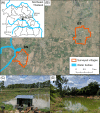Examining ecosystem (dis-)services on liver fluke infection in rural Northeast Thailand
- PMID: 37076937
- PMCID: PMC10114451
- DOI: 10.1186/s40249-023-01079-y
Examining ecosystem (dis-)services on liver fluke infection in rural Northeast Thailand
Abstract
Background: The direct reliance of humans on and their interactions with freshwater ecosystems in the Lower Mekong Basin have given rise to parasitic infections, which is particularly prevalent in Northeast Thailand where raw fish consumption is practiced. This study examined the interactions between environments, ecosystem (dis-)services, human raw fish consumption habits, and raw fish dish sharing on liver fluke infection risk.
Method: Water fecal contents and the first intermediate snail host were sampled between June and September of 2019. One hundred twenty questionnaires were surveyed in two villages of different environmental surroundings, one next to a river and the other located inland, in Northeast Thailand. Multivariate regression analyses using linear mixed effect models assessed the influence of social, behavioral and perceptual factors on raw fish consumption frequency, willingness to avoid consumption and liver fluke infection status. Social network analysis compared the degree of raw fish dish sharing between the villages and assessed the probable influence of connections to fish procurement locations and sharing activities on liver fluke infection risk.
Results: High abundance of the first intermediate snail host and presence of fecal contamination in water could endanger both villages to ecosystem disservices of parasitic transmission. The river-side village relied more on provisioning ecosystem services than the inland village (29.7% vs. 16.1% of villages) to consume raw fish as their main source of protein. Males in both villages (64.5 and 40.4 days/year for the respective villages) are also likely to consume koi pla and pla som, higher risk fish dishes, more frequently than females (4.1 and 4.3 days/year for the respective villages). The consumption habits of both villages were driven mostly by deriving cultural ecosystem services. Participation in raw fish dish sharing activities significantly reduced the odds of an individual being willing to avoid the consumption (Odds ratio = 0.19). Network analysis suggested that river-side villagers had a more direct raw fish dish sharing interaction and they procured fish from multiple locations; these characteristics might potentially account for more liver fluke infected households in the village.
Conclusion: Villagers' raw fish consumption is driven by deriving cultural ecosystem services, and the geographic settings of the villages potentially affect villagers' fish procurement locations and infection risk. The findings underscore the linkages between villagers and their surrounding ecosystem environments as pertinent determinants for foodborne parasitic disease risk.
Keywords: Cultural ecosystem service; Ecosystem disservice; Human-environment interaction; Liver fluke infection; Neglected tropical disease; One health.
© 2023. The Author(s).
Conflict of interest statement
The authors declare that they have no competing interests.
Figures



Similar articles
-
Masculinity and misinformation: Social dynamics of liver fluke infection risk in Thailand.Parasitol Int. 2021 Oct;84:102382. doi: 10.1016/j.parint.2021.102382. Epub 2021 May 11. Parasitol Int. 2021. PMID: 33984515
-
Fish sharing as a risk factor for Opisthorchis viverrini infection: evidence from two villages in north-eastern Thailand.Infect Dis Poverty. 2017 Apr 4;6(1):66. doi: 10.1186/s40249-017-0281-7. Infect Dis Poverty. 2017. PMID: 28372560 Free PMC article.
-
Social Influence in Liver Fluke Transmission: Application of Social Network Analysis of Food Sharing in Thai Isaan Culture.Adv Parasitol. 2018;101:97-124. doi: 10.1016/bs.apar.2018.05.004. Epub 2018 May 31. Adv Parasitol. 2018. PMID: 29907257 Free PMC article. Review.
-
Social network analysis of food sharing among households in opisthorchiasis endemic villages of Lawa Lake, Thailand.Acta Trop. 2017 May;169:150-156. doi: 10.1016/j.actatropica.2017.02.001. Epub 2017 Feb 8. Acta Trop. 2017. PMID: 28188767
-
Current status of human liver fluke infections in the Greater Mekong Subregion.Acta Trop. 2021 Dec;224:106133. doi: 10.1016/j.actatropica.2021.106133. Epub 2021 Sep 10. Acta Trop. 2021. PMID: 34509453 Review.
Cited by
-
Accuracy of a new rapid diagnostic test for urinary antigen detection and assessment of drug treatment in opisthorchiasis.Infect Dis Poverty. 2023 Nov 21;12(1):102. doi: 10.1186/s40249-023-01162-4. Infect Dis Poverty. 2023. PMID: 37990282 Free PMC article.
-
Global, regional and national disease burden of food-borne trematodiases: projections to 2030 based on the Global Burden of Disease Study 2021.Infect Dis Poverty. 2024 Dec 16;13(1):95. doi: 10.1186/s40249-024-01265-6. Infect Dis Poverty. 2024. PMID: 39676162 Free PMC article.
-
Social Determinants of Health Associated with Cholangiocarcinoma Risk in High-Risk Areas of Thailand: A Case-Control Study.Asian Pac J Cancer Prev. 2024 Nov 1;25(11):4081-4088. doi: 10.31557/APJCP.2024.25.11.4081. Asian Pac J Cancer Prev. 2024. PMID: 39611933 Free PMC article.
-
Orientation of One Health development: think globally and act locally.Sci One Health. 2023 Sep 30;2:100042. doi: 10.1016/j.soh.2023.100042. eCollection 2023. Sci One Health. 2023. PMID: 39077032 Free PMC article. Review.
References
-
- Oosterbroek B, de Kraker J, Huynen MM, Martens P. Assessing ecosystem impacts on health: a tool review. Ecosyst Serv. 2016;17:237–54. doi: 10.1016/j.ecoser.2015.12.008. - DOI
MeSH terms
Substances
Grants and funding
LinkOut - more resources
Full Text Sources
Research Materials

